A model of radical empathy: Barcelona’s architecture festival
Earlier this year, the second edition of Barcelona’s architectural festival took place. Under the overarching theme of Radical Empathy, it encompassed experimental constructions, digital interventions, participatory discovery& looking at what the future of the Catalan city might look like.
In a world of biennales, triennales, you may wonder if
there’s room for even more architecture festivals. In Barcelona, the second
edition of Model. Barcelona Architectures Festival looked to do something
different to some other headline-seeking celebrations of global architecture
and design. With a fundamentally local focus, it is designed to provoke new ideas
for the future of the city and to offer the public new ways to re-see what is
already present.
It's all curated by Eva Franch i Gilabert, former head of the Architecture Association in London and Storefront for Art and Architecture in New York. She had just arrived in Barcelona, the city she had previously studied architecture in, on a research sabbatical when an email popped into her inbox asking if she’d be interested in overseeing the proposed festival. It was too much of a coincidence for her to turn down.
![]()
The title, MODEL, is a nod to The Barcelona Model, the post-1992 Olympic period strategy of urban regeneration rooted around a mix of public/private partnerships, starchitecture, and investing in public space, all wrapped up in place-marketing and creating a city brand. It also speaks to the notion of the architectural model and its ability to test forms, ideas, or programme before scaling up or rolling out more widely. Also, and importantly, it is about architectures – with an S – to suggest not a singular design process but a plurality of approaches which encompasses not only buildings but also landscape and urban strategies.
The festival itself is wider than just architecture, too. The 2023 edition, held over ten days in April, encompassed literature, walking tours, academic courses, family activities, talks and more. Each edition has a theme and central location, allowing focus upon issues and place. This years was looking at Empatia Radical – or Radical Empathy in English – with much of the programme centred around Parc de les Glòries, a vast building site at the foot of the Jean Nouvel-designed Torres Glòries, which glowed in MODEL pink and green for the opening of the festival. Once the building site hoardings are removed, it will be the site of a vast new 20,000m² public park where once a vast motorway roundabout stood.
The roads have not been removed, just buried into 1km-long tunnels, and while the future park will enrich biodiversity and bring new public space into the city, there are local concerns that it will also gentrify the El Clot area of the city, deeply working class and one of the few areas of affordable living remaining. The new park will directly El Clot to the business, tech, and tourism hub developing in the once-industrial area streets around Torres Glòries. One giant building forming part of the area’s gentrification is the 720 Fermín Vázquez Arquitectos designed Mercats dels Encants, which houses a fleamarket which once wrapped itself around every crevice of the flyovers and roundabout – nobody argues that it’s a shame the concrete infrastructure has gone, but the some say the new market with regulations and spatial management does limit who can buy and sell compared to that which went before.
![]()
![]()
![]()
Urban currents and repercussions like this make city planning and building precarious. The original Barcelona Model is credited with rescuing the city, enabling its modern identity, putting it onto the tourist map, and facilitating countless architectural and urban projects. However, it is this rapid shift which has increased the cost of living in the city for locals, the rise of AirBnB and protests around it, and eventually the 2015 election of Ada Colau of political party and citizen platform Barcelona en Comú, a position held until one week after this year’s edition of MODEL.
Through a series of pop-up pavilions around the Glòries area, MODEL tested potential future urban projects. Located on the pedestrianised former motorway, Mamifer, by feminist collective Equal Saree, was a timber construction to enable breastfeeding, correct-temperature storage of breast milk, baby-changing facilities, and a space to relax with other babies and parents. Franch pointed out that Barcelona has countless free places to charge a mobile phone, but not a single one to warm milk for a baby, and as an intervention it asks questions around who the city is for and what activities it should facilitate. She hopes that it may lead to similar stations in the city, if the council can reimagine civic management to allow such nuanced infrastructure to exist.
![]()
![]()
![]()
![]()
Free Air by Daryn Knoblauch was a structure formed of reusable materials with a mesh which can extract small amounts of NO2 from the air, doubling up as an events and meeting space for conversations around urban pollution and particulates. Feral Surfaces from New York-based Harrison Atelier offered a mycelium landscape for some of the smaller non-human residents of Barcelona – a system of 1500 hemp-based panels which can act as home to insects and bees, with surrounding. Theoretically, this is a process which could be installed and maintained easily across urban surfaces.
A playful hunt through seven warehouses that store redundant urban materials resulted in Permanently Temporary by KOSMOS x PARABASE architects. Construction site mesh stretched over a tower made of water-storage tanks and trapped to the ground by concrete blocks, curb stones, and spherical bollards. In an age of reuse and reappropriation, it spoke to new ideas formed of the waste and abandoned elements of the past, questioning perpetual newness. Over the course of MODEL it acted as a place for talks about reuse as well as a participatory remakery in which new objects were formed from donated and found material.
![]()
![]()
![]()
![]()
![]()
![]()
The last of the pop-up installations was Nomad Assembly by h3o Architects, a playful suite of shockingly-pink intervention furniture for Mercats dels Encants, serving as base-camp for the festival’s awards and ceremonies, as well as a book fair coinciding with the city-wide Sant Jordi’s Day book festival. Curated by Ethel Baraona, co-founder of research studio and publisher dpr-Barcelona, various bookshops and cultural organisations were invited to participate alongside talks and discussions.
Connecting to the festival name, models for future living were considered in exhibition 73 Barcelones, organised by local trio Noa
Yarkoni, Mar Gené, and Tiffany B. Whittaker. Breaking the city apart into 73 neighbourhoods, various designers and architects presented a single poster to reflect upon or present idea for each place. Hung in the basement of MBM-designed Disseny Hub Barcelona, home to the city’s design museum, the series of imaginings offer a variety of ways of reading and redrawing the city.
![]()
![]()
![]()
Future imaginaries are increasingly not formed of pen or pencil on paper, however. A strand of MODEL is designed to entertain digital and augmented reality architectures, with four commissions to invite technology into the conversation. Catalan visual artist Victor Enrich created an enormous Archigram-like marine platform, seen using augmented reality when a mobile phone was held up to the void above the open first-phase of Parc de les Glòries. Not only a huge lump of architecture absurdly sited in the city, it is also political comment upon the Castor marine gas plant, funded by the Spanish government but now set to be dismantled having caused hundreds of earthquakes.
New Jersey based architects Besler & Sons developed City Suite IMS, a platform which imagines the city as a storage warehouse packed full of opportunity. Architects IAAC created Ecologies connectades, a digital sound portal connected to from various locations and invited non-anthropocentric ways of considering the city. Finally, Protests Archive by designer and researcher Farah Michel was a virtual landscape which collected first-person recollections of opposition and protest. Barcelona is a city which has had more than most, from opposition to Franco through to pro-independence movements, and this participatory project sought to create a mapping which returns cultural memory to citizens and away from mediated or politicised narratives.
Elsewhere over the ten days talks, classes, walks, and more brought various architectures to both general citizen and urban experts alike. It’s a big ask to present something this broad and diverse as an annual event, especially in a city not short of festivals and cultural happenings. In a city so celebrated for urban design and architecture, it is good that there is space for a dedicated festival – and perhaps ideas gestated within it may progress from model to actuality under new mayor Jaume Collboni, the city’s first openly-gay mayor who has declared he will oversee “without new exclusions, without an agenda of impositions, a green transition with a red heart.”
It's all curated by Eva Franch i Gilabert, former head of the Architecture Association in London and Storefront for Art and Architecture in New York. She had just arrived in Barcelona, the city she had previously studied architecture in, on a research sabbatical when an email popped into her inbox asking if she’d be interested in overseeing the proposed festival. It was too much of a coincidence for her to turn down.

The title, MODEL, is a nod to The Barcelona Model, the post-1992 Olympic period strategy of urban regeneration rooted around a mix of public/private partnerships, starchitecture, and investing in public space, all wrapped up in place-marketing and creating a city brand. It also speaks to the notion of the architectural model and its ability to test forms, ideas, or programme before scaling up or rolling out more widely. Also, and importantly, it is about architectures – with an S – to suggest not a singular design process but a plurality of approaches which encompasses not only buildings but also landscape and urban strategies.
The festival itself is wider than just architecture, too. The 2023 edition, held over ten days in April, encompassed literature, walking tours, academic courses, family activities, talks and more. Each edition has a theme and central location, allowing focus upon issues and place. This years was looking at Empatia Radical – or Radical Empathy in English – with much of the programme centred around Parc de les Glòries, a vast building site at the foot of the Jean Nouvel-designed Torres Glòries, which glowed in MODEL pink and green for the opening of the festival. Once the building site hoardings are removed, it will be the site of a vast new 20,000m² public park where once a vast motorway roundabout stood.
The roads have not been removed, just buried into 1km-long tunnels, and while the future park will enrich biodiversity and bring new public space into the city, there are local concerns that it will also gentrify the El Clot area of the city, deeply working class and one of the few areas of affordable living remaining. The new park will directly El Clot to the business, tech, and tourism hub developing in the once-industrial area streets around Torres Glòries. One giant building forming part of the area’s gentrification is the 720 Fermín Vázquez Arquitectos designed Mercats dels Encants, which houses a fleamarket which once wrapped itself around every crevice of the flyovers and roundabout – nobody argues that it’s a shame the concrete infrastructure has gone, but the some say the new market with regulations and spatial management does limit who can buy and sell compared to that which went before.
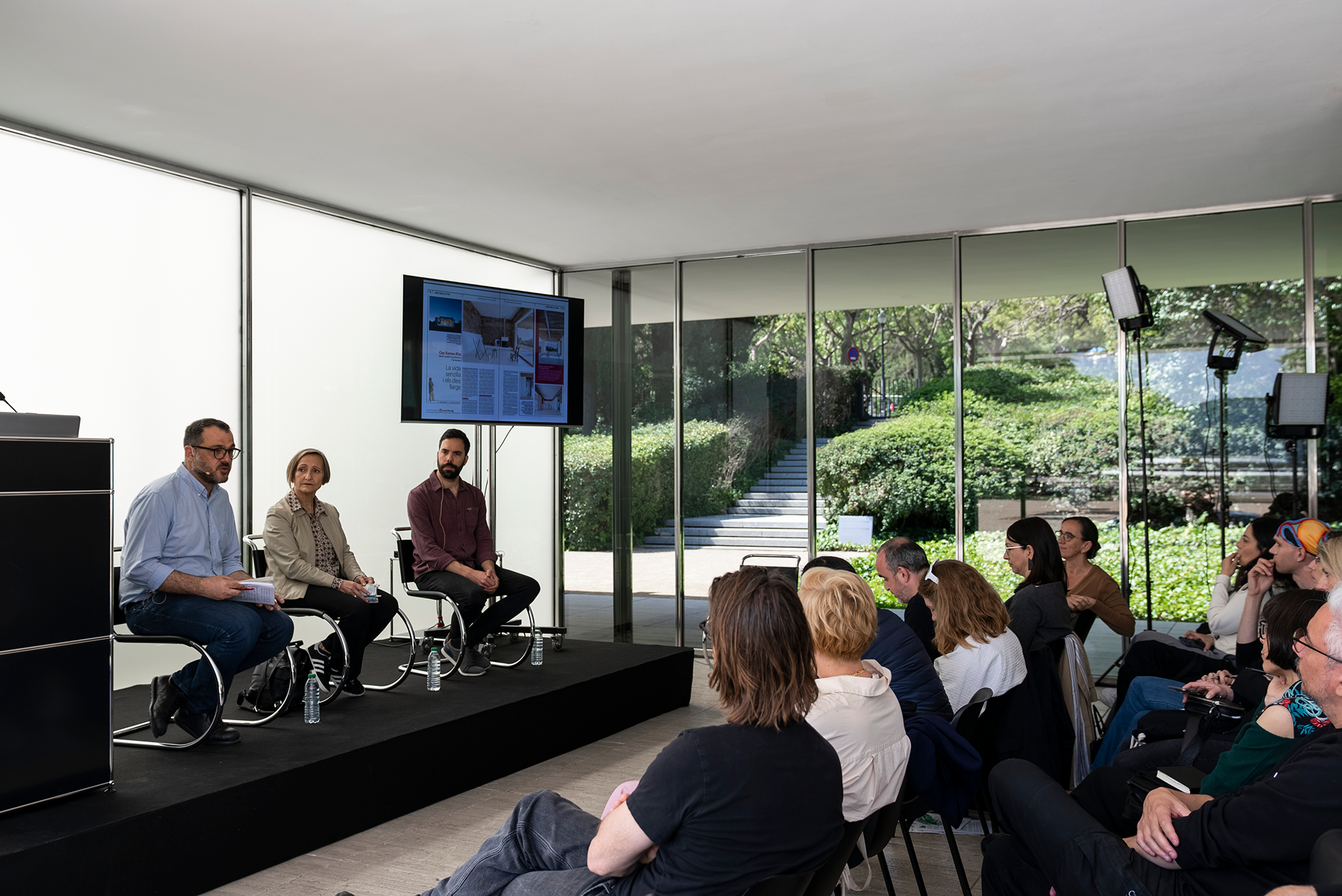
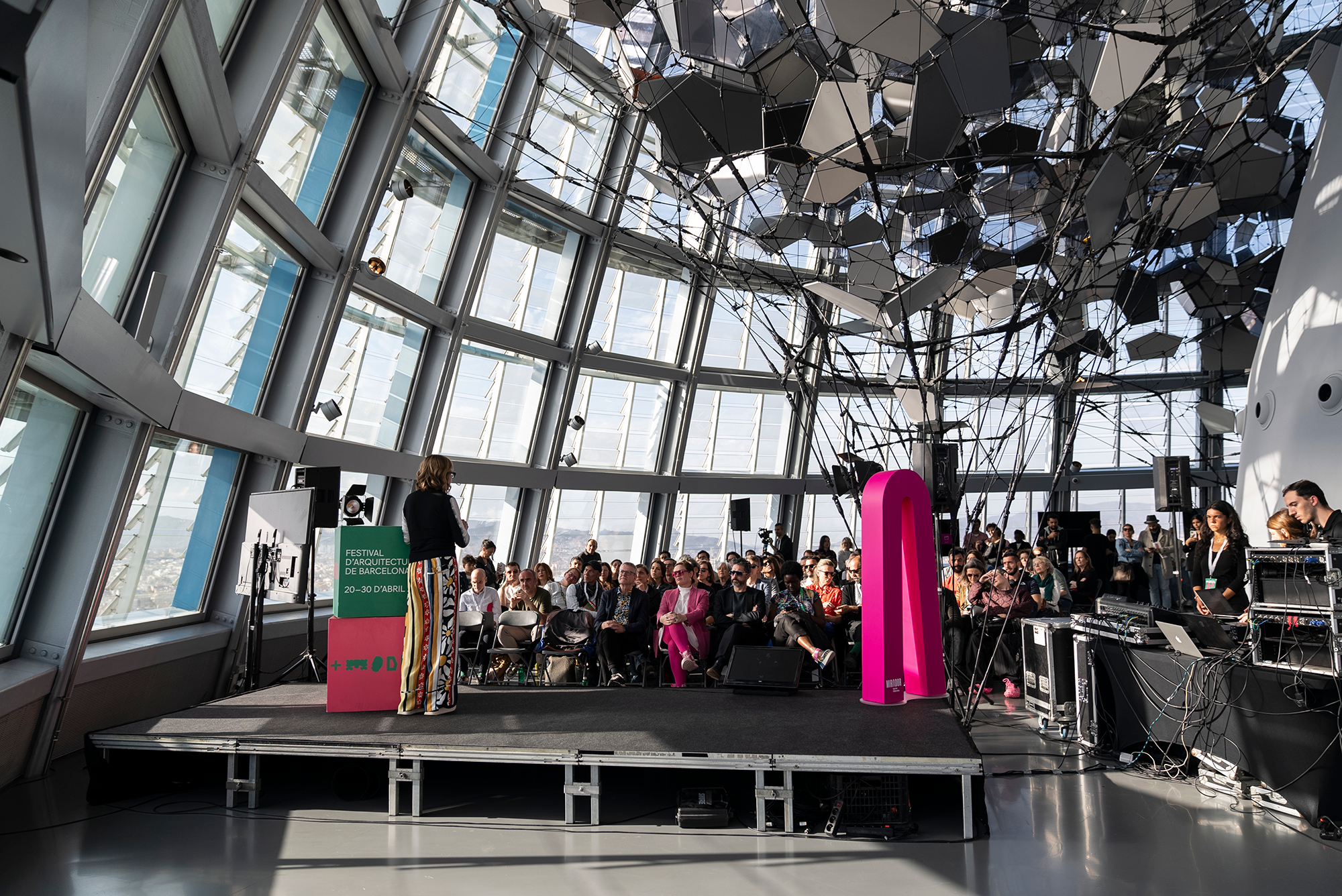
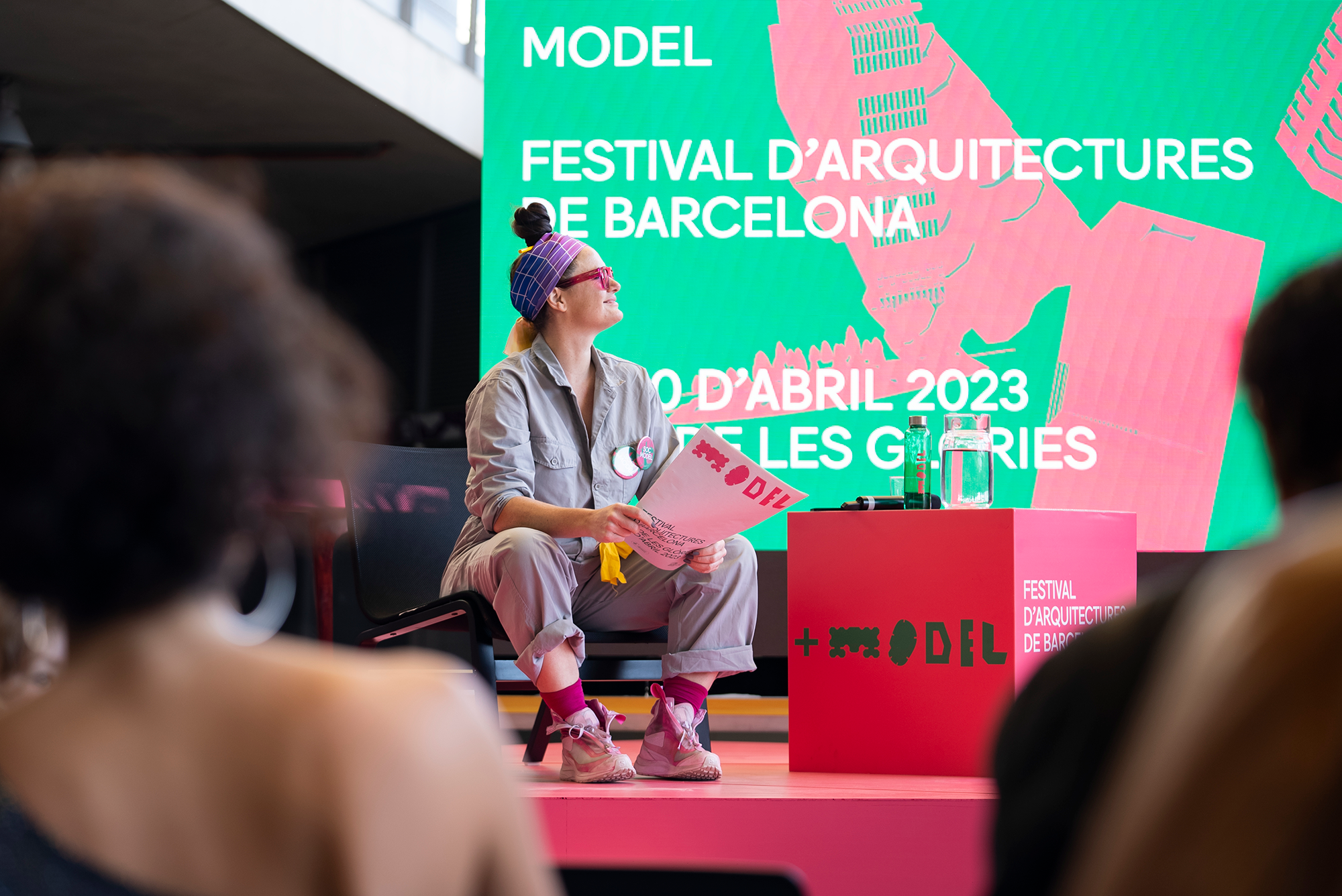
Urban currents and repercussions like this make city planning and building precarious. The original Barcelona Model is credited with rescuing the city, enabling its modern identity, putting it onto the tourist map, and facilitating countless architectural and urban projects. However, it is this rapid shift which has increased the cost of living in the city for locals, the rise of AirBnB and protests around it, and eventually the 2015 election of Ada Colau of political party and citizen platform Barcelona en Comú, a position held until one week after this year’s edition of MODEL.
Through a series of pop-up pavilions around the Glòries area, MODEL tested potential future urban projects. Located on the pedestrianised former motorway, Mamifer, by feminist collective Equal Saree, was a timber construction to enable breastfeeding, correct-temperature storage of breast milk, baby-changing facilities, and a space to relax with other babies and parents. Franch pointed out that Barcelona has countless free places to charge a mobile phone, but not a single one to warm milk for a baby, and as an intervention it asks questions around who the city is for and what activities it should facilitate. She hopes that it may lead to similar stations in the city, if the council can reimagine civic management to allow such nuanced infrastructure to exist.




Free Air by Daryn Knoblauch was a structure formed of reusable materials with a mesh which can extract small amounts of NO2 from the air, doubling up as an events and meeting space for conversations around urban pollution and particulates. Feral Surfaces from New York-based Harrison Atelier offered a mycelium landscape for some of the smaller non-human residents of Barcelona – a system of 1500 hemp-based panels which can act as home to insects and bees, with surrounding. Theoretically, this is a process which could be installed and maintained easily across urban surfaces.
A playful hunt through seven warehouses that store redundant urban materials resulted in Permanently Temporary by KOSMOS x PARABASE architects. Construction site mesh stretched over a tower made of water-storage tanks and trapped to the ground by concrete blocks, curb stones, and spherical bollards. In an age of reuse and reappropriation, it spoke to new ideas formed of the waste and abandoned elements of the past, questioning perpetual newness. Over the course of MODEL it acted as a place for talks about reuse as well as a participatory remakery in which new objects were formed from donated and found material.
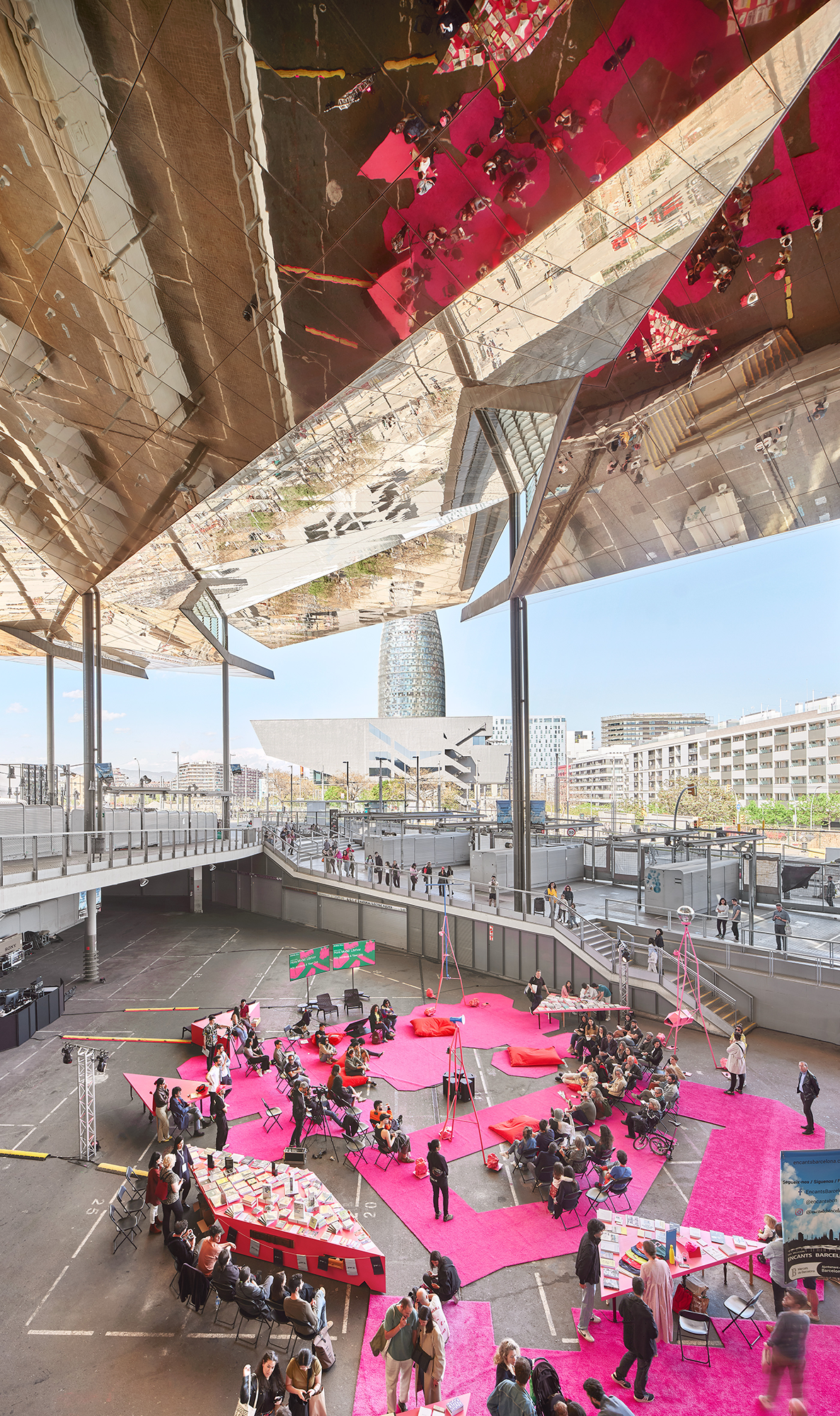



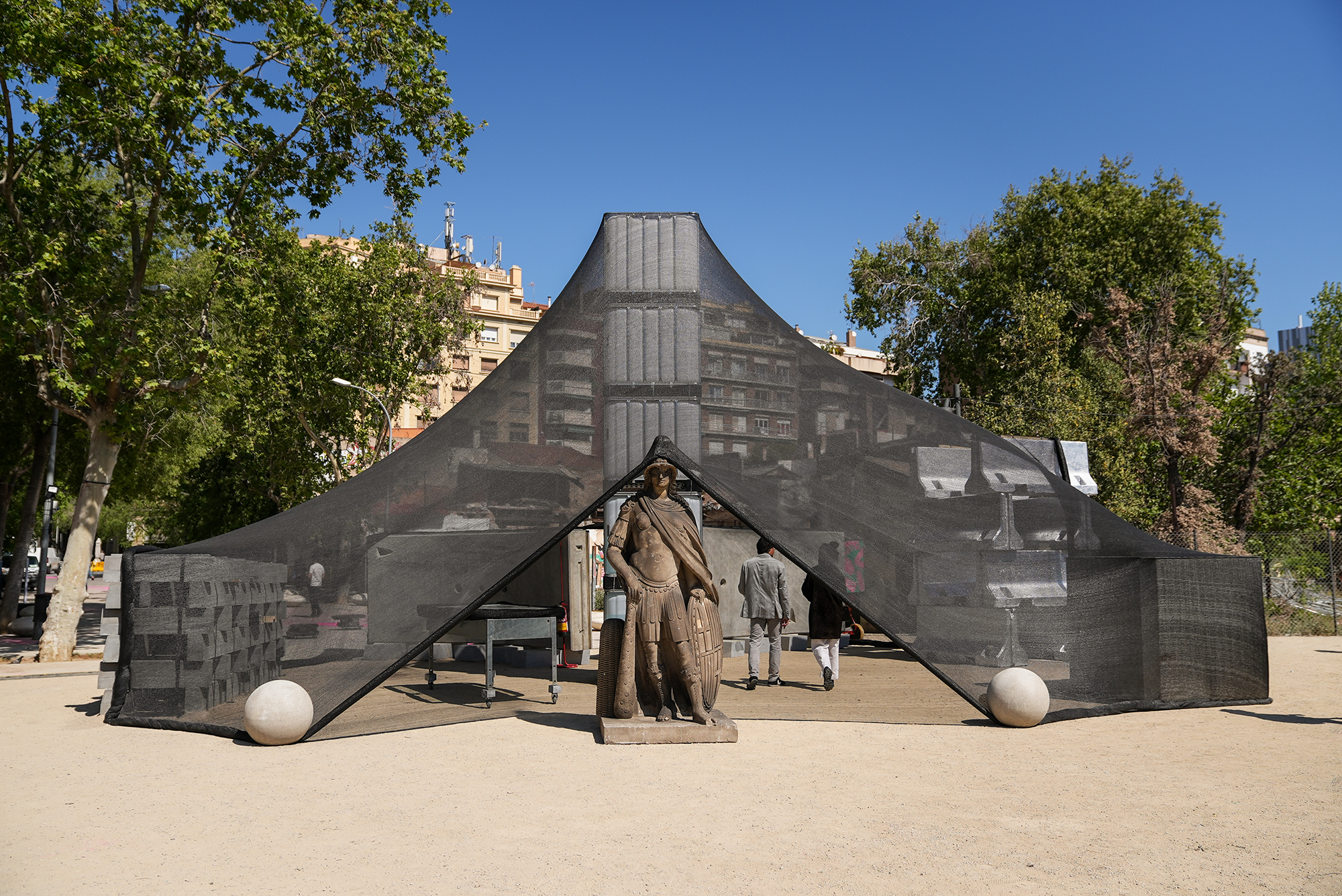

The last of the pop-up installations was Nomad Assembly by h3o Architects, a playful suite of shockingly-pink intervention furniture for Mercats dels Encants, serving as base-camp for the festival’s awards and ceremonies, as well as a book fair coinciding with the city-wide Sant Jordi’s Day book festival. Curated by Ethel Baraona, co-founder of research studio and publisher dpr-Barcelona, various bookshops and cultural organisations were invited to participate alongside talks and discussions.
Connecting to the festival name, models for future living were considered in exhibition 73 Barcelones, organised by local trio Noa
Yarkoni, Mar Gené, and Tiffany B. Whittaker. Breaking the city apart into 73 neighbourhoods, various designers and architects presented a single poster to reflect upon or present idea for each place. Hung in the basement of MBM-designed Disseny Hub Barcelona, home to the city’s design museum, the series of imaginings offer a variety of ways of reading and redrawing the city.

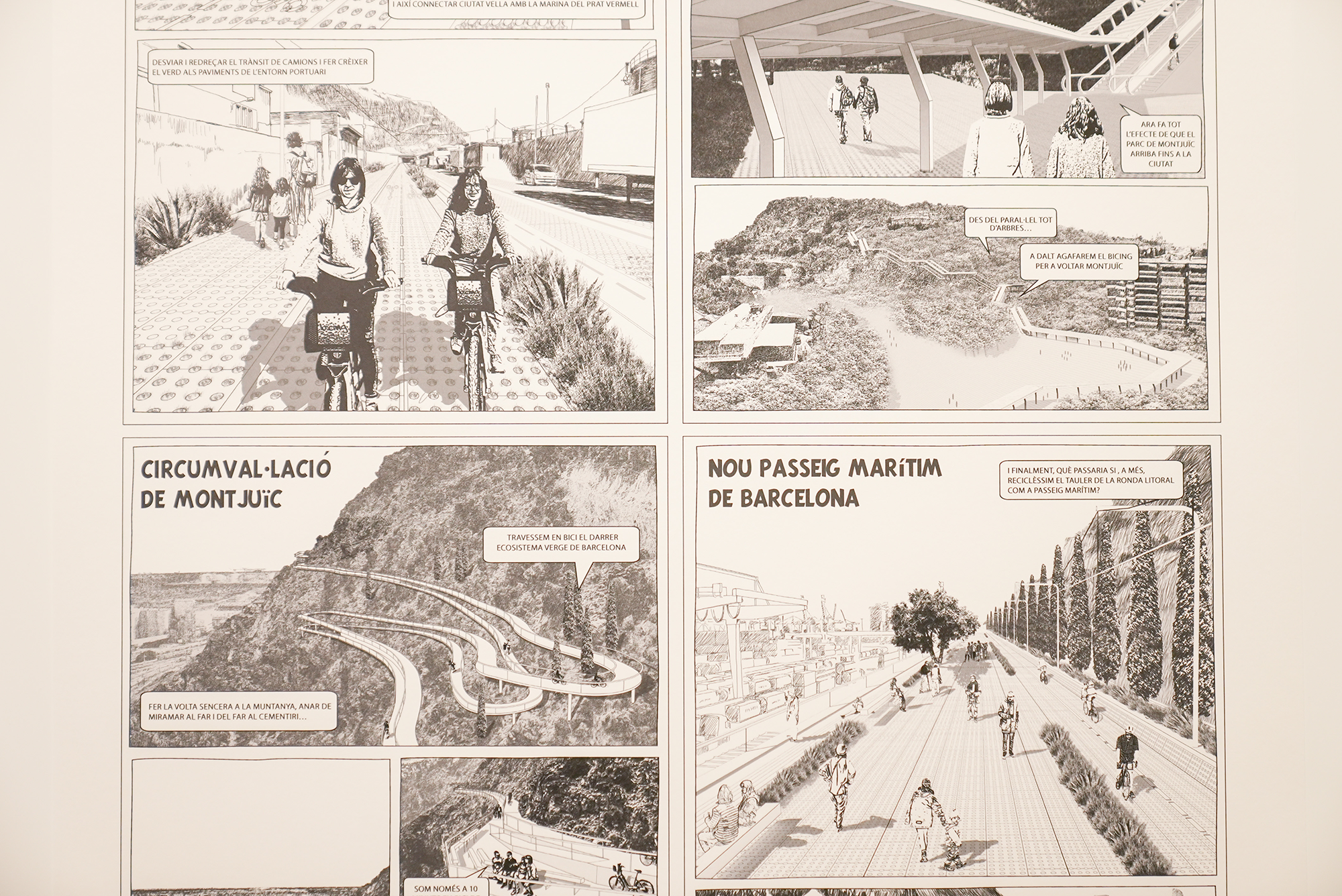

Future imaginaries are increasingly not formed of pen or pencil on paper, however. A strand of MODEL is designed to entertain digital and augmented reality architectures, with four commissions to invite technology into the conversation. Catalan visual artist Victor Enrich created an enormous Archigram-like marine platform, seen using augmented reality when a mobile phone was held up to the void above the open first-phase of Parc de les Glòries. Not only a huge lump of architecture absurdly sited in the city, it is also political comment upon the Castor marine gas plant, funded by the Spanish government but now set to be dismantled having caused hundreds of earthquakes.
New Jersey based architects Besler & Sons developed City Suite IMS, a platform which imagines the city as a storage warehouse packed full of opportunity. Architects IAAC created Ecologies connectades, a digital sound portal connected to from various locations and invited non-anthropocentric ways of considering the city. Finally, Protests Archive by designer and researcher Farah Michel was a virtual landscape which collected first-person recollections of opposition and protest. Barcelona is a city which has had more than most, from opposition to Franco through to pro-independence movements, and this participatory project sought to create a mapping which returns cultural memory to citizens and away from mediated or politicised narratives.
Elsewhere over the ten days talks, classes, walks, and more brought various architectures to both general citizen and urban experts alike. It’s a big ask to present something this broad and diverse as an annual event, especially in a city not short of festivals and cultural happenings. In a city so celebrated for urban design and architecture, it is good that there is space for a dedicated festival – and perhaps ideas gestated within it may progress from model to actuality under new mayor Jaume Collboni, the city’s first openly-gay mayor who has declared he will oversee “without new exclusions, without an agenda of impositions, a green transition with a red heart.”
Model. Barcelona Architectures Festival is a space for reflection and celebration that brings us experimental architecture and helps us to rethink how we wish to live together through new city models and imaginaries.
Launched by Barcelona City Council and the Catalan Architects' Association (COAC) in 2022, this year it has been organised through the Fundació Mies van der Rohe, with Eva Franch i Gilabert as its artistic director, in collaboration with a broad team of architects, curators and more than 50 of the city’s institutions and organisations, chosen through an open call for entries.
Model aims to turn urban spaces into a platform for architectural talent and up-and-coming design, the city into a meeting forum for leading thinkers from around the world and, more significantly, architecture into a space for exploration and inspiration for all the city's residents.
www.model.barcelona
visit
MODEL. Barcelona Architectures Festival 2023, Radical Empathy, took place 20-30 April 2023. For future editions check the following website:
www.model.barcelona
images
All photos courtesy of MODEL. Barcelona Architectures Festival.
publication date
04 August 2023
tags
Augmented reality, Ethel Baraona, Barcelona, Besler & Sons, Civic, Ada Colau, Jaume Collboni, Digital, El Clot, Victor Enrich, Equal Saree, Eva Franch i Gilabert, DHUB, Fermín Vázquez Arquitectos, Festival, Mar Gené, h3O Architects, Harrison Atelier, Kosmos Architects, Daryan Knoblauch, Landscape, MBM, Mercats dels Encants, Model Barcelona Architecture Festival, Farah Michel, Mycelium, Jean Nouvel, Parabase, Parc de les Glòries, Public space, Protest, Radical Empathy, Reuse, San Jordi, Torres Glòries, Tiffany B Whittaker, Urban design, Noa Yarkoni
www.model.barcelona


